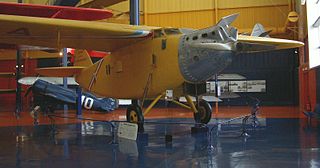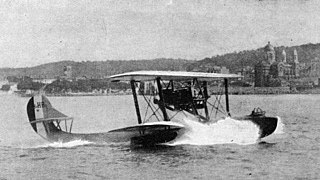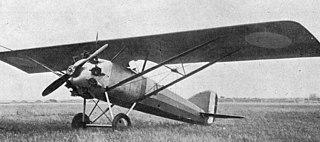
The Bartel BM 5, initially known as M.5 was a Polish biplane advanced trainer used from 1930 to 1939 by the Polish Air Force, manufactured in the Samolot factory in Poznań.

The Bernard 190 or Bernard-Hubert 190 was a French airliner of 1928. It was a high-wing cantilever monoplane of conventional configuration, based on the Bernard 18. Compared with its predecessor, it kept the same basic design but featured redesigned tail surfaces, an enlarged cabin, and offered its flight crew a completely enclosed cockpit. Also like its predecessor, the basic airliner model provided the basis for a long-range aircraft to be used in record attempts, the 191GR.

The Blanchard Brd.1 was a French reconnaissance flying boat, to the 1923 STAé HB.3 specification, used by the French navy in the 1920s. It was a large biplane with two engines mounted in the gap between the wings, each engine driving a pusher propeller. In 1924, one Brd.1 was used to set several world altitude records for seaplanes.

The Breda A.4 was a biplane trainer produced in Italy in the mid-1920s. It was of conventional configuration with a two-bay unstaggered wing cellule and seating for the pilot and instructor in tandem open cockpits. Apart from civil use, the A.4 was also adopted by the Regia Aeronautica as a trainer. At least some examples were produced in floatplane configuration as the A.4idro.

The CAMS 46 was a flying boat trainer aircraft built in France in the mid-1920s, essentially an updated version of the CAMS 30 that had flown in 1922. While retaining that aircraft's basic form, CAMS offered the French Navy two new versions with aerodynamic refinements over the earlier aircraft: the CAMS 46 E primary trainer, and the CAMS 46 ET intermediate trainer. Only the latter was selected for production and was built in quantity to supply one escadrille at the Naval training station at Hourtin.

The Caudron R.11, was a French three-seat twin-engine long range escort fighter biplane developed and produced by Caudron during the First World War.
The Farman F.120 were a family of multi-engine monoplane aircraft designed and produced by the French aircraft manufacturer Farman Aviation Works. It was operated in a diverse range of purposes, including as a commercial airliner and as a military bomber aircraft.

The Morane-Saulnier MS.230 aircraft was the main elementary trainer for the French Armée de l'Air throughout the 1930s. Almost all French pilots flying for the Armée de l'Air at the outbreak of World War II had had their earliest flight training in this machine. It was the equivalent of the Stearman trainer in the United States air services and the de Havilland Tiger Moth in the British Royal Air Force.

The Fokker C.VIII was a reconnaissance aircraft built in the Netherlands in the late 1920s. Intended primarily for the photographic reconnaissance role, it was a larger machine than other Fokker reconnaissance types of the period, with space for a third crew member, who acted as camera operator. It was also Fokker's first aircraft of this type to be built as a monoplane, a parasol wing configuration. The construction, however, was in the familiar Fokker style with wooden wings covered with plywood and fabric, and a steel-tube fuselage, also fabric-covered.

The Gourdou-Leseurre GL.30 was a racing aircraft built in France in 1920 which formed the basis for a highly successful family of fighter aircraft based on the same design.
The Renard Epervier was a Belgian prototype single-seat all-metal fighter monoplane designed by Alfred Renard at the Societé Anonyme Avions et Moteurs Renard for a government-sponsored design contest in 1928. The Epervier Type 2 was built and flown in 1928, by Belgian aircraft manufacturer Stampe et Vertongen. It carried an armament of two synchronised 7.7mm guns and was lost in September 1928 after failing to recover from a flat spin. A second prototype, the Epervier Type 2bis, introduced revised streamlined fairings for the cantilever mainwheel legs, mainwheel spats and cylinder aft-fairings and was built by SABCA.

The Letov Š-4 was a Czechoslovak single-bay, unstaggered biplane fighter and trainer in the 1920s.
The Beardmore W.B.II was a British biplane fighter prototype of the 1910s.

The Nieuport 14 was a military reconnaissance sesquiplane produced in France during the First World War. The French Army deployed it in 1916 but the type was quickly withdrawn from front-line service.

The Caproni Ca.355 Tuffo was a low-wing single-engine dive bomber, designed and built by the Italian Caproni company in 1941, which never proceeded beyond a single prototype. Derived from Ca.335 Mistral, the Ca.355 was proposed to equip the Regia Aeronautica, but it was found to offer little advantage over the German Junkers Ju 87 "Stuka" and the project was abandoned.

The Voisin Triplanes were large experimental bombers built by Voisin in 1915 and 1916. After unsuccessful trials of the 1915 prototype a modified version with more powerful engines was built in 1916, as the Voisin E.28, but the type did not enter production.

The de Marçay 2 C1 was a prototype single-seat biplane fighter designed in France and first flown in 1919. It did not go into production.

The Borel-Boccaccio Type 3000, also known as Borel C2, was a two-seat fighter designed and built in France to a 1918 C2 specification.

The Hiro H3H1 or Navy Type 90-1 Flying boat was a Japanese flying boat bomber built in 1931. It was the first large all-metal aircraft built in Japan. Only one was completed.

Proto 2 was a training biplane manufactured at the Fabrica de avioane Astra in Arad in 1924.

















